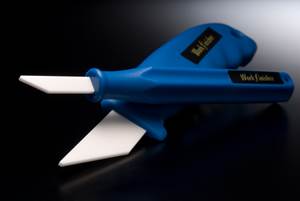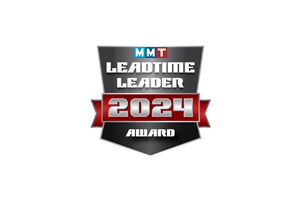Leaving Your Welding to A Pro Guarantees Longer Tool Life and A Job Done Right the First Time
It seems like moldmakers have enough on their plate - smaller timeframe to complete molds, offshore competition, finding qualified employees - to add mold repair/welding to the long list.
It seems like moldmakers have enough on their plate - smaller timeframe to complete molds, offshore competition, finding qualified employees - to add mold repair/welding to the long list. Thus, it makes sense to outsource this part of the process, as it seems to be unfamiliar territory for most moldmakers.
According to Connie and David Randal of Santa Ana, CA-based Randal Welding & Machine, there is a huge difference be-tween welding and welding tool steel, and not many possess complete knowledge of the latter.
"If you have the ability to provide quality tool steel welding in-house, by all means do so," Connie states. "But, people confuse the ability of someone who can weld parts with someone who can weld tool steel."
David echoes these sentiments. "The problems using a nonprofessional welder causes down the road are unbelievable," he stresses, "like premature fract-uring, cracking at the initial weld. The aftermath and cleaning up the mess is very expensive and may not even be salvageable."
All of the aforementioned reasons contributed to moldmaker Joe Adlesh's decision to outsource welding. Adlesh, the president of Santa Ana, CA-based Industrial Tool & Die, has been outsourcing welding for about 30 years. "There's too much knowledge that is needed to weld tool steels to hire someone and keep that person busy," he states.
The same goes for Rod Yaklin, the owner of R.D. Molds, San Clemente, CA, a provider of high production injection tooling for all of the plastics industries. "The lack of a qualified welder onsite and the cost factor are what led me to outsource," he states. "I don't weld myself, and even if I could I couldn't match the quality and the accuracy of a professional. Also, it's much easier for a small company like myself to not invest money in a welder and someone who can operate welding equipment."
The World of Welding
So, what should a moldmaker do to ensure a quality mold weld that will increase tool life? Outsource, of course! A professional welder has a broader contact base, is exposed to a larger variety of molds and tool materials, has a range of tool steel weld rods, and possesses all of the necessary equipment to preheat and postheat the molds during the weld process, Connie maintains.
"Preheating and postheating of the tools is a very critical part of the welding process and very time-consuming," she explains. "Usually when the mold is welded in-house, the production schedule dictates the process and these two processes usually get vetoed. When preheats and postheats are not taken care of as they should, it puts the tool in jeopardy of cracking. Also, many moldmaking shops don't have any means of heating tools other than a torch, which is totally inappropriate."
R.D. Molds' Yaklin agrees. "It's a lot less trouble to send it out and get it done right the first time," he comments. "It's hard to find someone to put in the hours to do a good weld. A specified welder does this all day long - that's how you get good at what you do, by doing in day in and day out."
Additionally, outsourcing the welding means the moldmaker does not have to maintain a library of tool steel data, heat treat data, and a computer database.
Making the Right Choice
"The welder should be an asset to the moldmaker and the tool," Connie affirms. "Unfortunately, much of the time the mold welder is the last resort for keeping a tool in service. The mold welder should be someone the moldmaker can turn to for help and not have the fear that the service given could worsen the problem. Find a welding shop that is capable of providing you with quality welds. Review your needs and requirements - such as maintaining color match, Rockwell match, etc. - things you feel are very crucial to the tool.
"Often a professional welder without a tool steel background has great difficulty with tool steels - not knowing the re-quirements or the unique characteristics of specific tool steels," she continues. "There are also unique characteristics of molds and moldmaking. The right mold weld provider should have a fundamental working knowledge of molds, should understand drafts, releases, shutoffs, surface gates, subgates, etc. and their function in relationship to the tool. This knowledge should be weighed on the same level as the provider's knowledge of tool steel and specific heat treat requirements and some reasonable metallurgical understanding."
Additionally, the weld provider should also have an understanding of surface coatings such as hard chrome, titanium nitride, and iron nitride, and also color matching and surface treatments such as texturing and polishing. "The provider's shop should have at least one microscope, a Rockwell tester and a means of identifying the temperature of the part - not only while preheating but also during the welding," she explains. "While thermo-crayons will work, a pyrometer or digital thermometer are more accurate.
"In addition to all of the above, the welder should have a large variety of welding rod inventory to meet your needs, such as H13, A2, D2, S7," Connie continues. "These rods should be carried in multiple diameters, from large to small. This will enable the welder to supply you with cosmetic welds as well as structural and buildup welds, and also shorten the downtime by not having to wait for welding rods to be purchased as-needed."
Connie recommends asking around to find a qualified welder in your area. All of their business has been word of mouth, she says. David adds that he works closely with the tool steel suppliers in his area and suggests that your local tool steel supplier is a good place to start.
Talk the Talk
Once you have found a professional welder you'd like to do business with, proper communication is essential even before the mold is in the design phase. David suggests contacting the welder for advice on specific materials - what the material is like, if it is repairable. "Bringing the welder on-board early in the process will improve the quality of the tool," he states. "Once you are on your way, if you make design changes, contact your welder."
Keep the lines of communication open as soon as a problem arises, David recom-mends. "The thing to do when a mold is being worked on and a mishap occurs, like a cutter plunge, EDM over-burn, etc., is to stop immediately and find out if it should be welded immediately or after the rest of the mold is complete," he says. "That is why you need to build a rapport with your welder."
Connie adds that the moldmaker needs to share details of his process with the welder to guarantee the best possible weld, for example, the type of tolerancing the moldmaker generally works with and how crucial it is to his process. "These kinds of discussions between the moldmaker and the welder help to eliminate misunderstandings," she states. "The moldmaker should have a standard worksheet or a form that covers specific needs and requests. The worksheet might cover such items as type and Rockwell of material, designate where to weld, and also include a blueprint or a small sketch. Then, the areas to be welded should also be identified on the part."
The worksheet helps the welder feel more comfortable, David maintains. "He can just go down the checklist to see what you want," he comments. "It's just like a pilot landing a plane - even though he's done it a thousand times he still has a checklist to follow to make sure nothing is omitted. This checklist can be fine-tuned between the moldmaker and welder through the months and years, and improvements made."
Being this specific leaves no room for ambiguity. "The tool steel welder has but one job and that is to weld the tool to the best of his ability," Connie affirms. And if the welder is performing to the best to his or her ability, it will show in the moldmaker's shop. "The first thing a customer does is look at your work," says Yaklin of R.D. Molds. "If it is cosmetically appealing to the eye, the customer will have more confidence in you. I rely on repeat business, so that is very important to me."
Related Content
Ceramic Deburring, Deflashing Tools Take Into Consideration Difficult Materials, Operator Safety
Boride Engineered Abrasives introduces its new mold polishing equipment, the Work Finisher Tool, which is lightweight, long lasting, won’t rust and is safer and easier to use.
Read MoreCertified Quality Management for Plastics Professionals – Materials to Tooling to Recycling
Why is certification of a shop’s quality management system to ISO 9001, AS9100, IATF 16949 or ISO 13485 so special? What does the certification signify? And what supports the paper behind the framed certificate?
Read MoreFAQs: What Are the Leadtime Leader Awards?
Here are answers to some frequently asked questions about MoldMaking Technology's annual Leadtime Leader Awards competition.
Read MoreMMT Chats: Marketing’s Impact on Mold Manufacturing
Kelly Kasner, Director of Sales and Marketing for Michiana Global Mold (MGM) talks about the benefits her marketing and advertising, MGM’s China partnership and the next-generation skills gap. This episode is brought to you by ISCAR with New Ideas for Machining Intelligently.
Read MoreRead Next
How to Use Continuing Education to Remain Competitive in Moldmaking
Continued training helps moldmakers make tooling decisions and properly use the latest cutting tool to efficiently machine high-quality molds.
Read MoreAre You a Moldmaker Considering 3D Printing? Consider the 3D Printing Workshop at NPE2024
Presentations will cover 3D printing for mold tooling, material innovation, product development, bridge production and full-scale, high-volume additive manufacturing.
Read MoreReasons to Use Fiber Lasers for Mold Cleaning
Fiber lasers offer a simplicity, speed, control and portability, minimizing mold cleaning risks.
Read More



.jpg;maxWidth=300;quality=90)








_300x250 1.png;maxWidth=300;quality=90)












